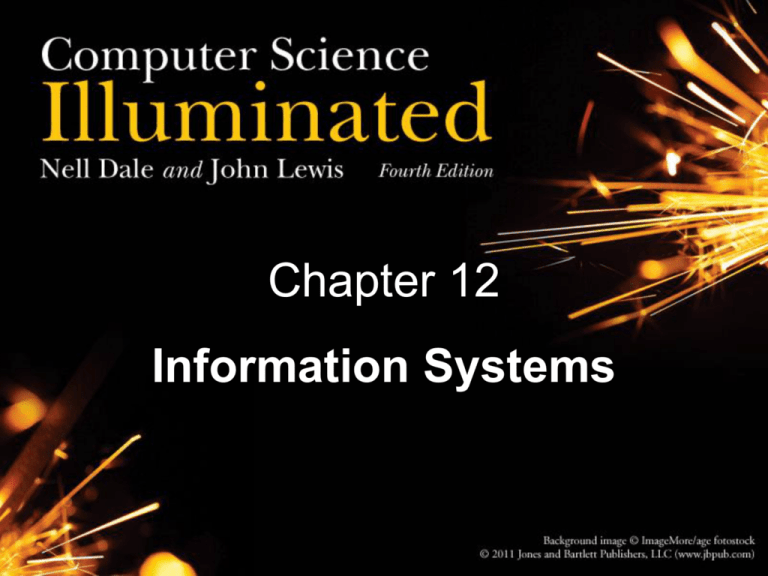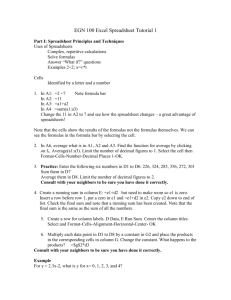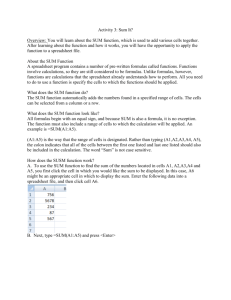Powerpoint
advertisement

Chapter 12 Information Systems Managing Information Information system Software that helps the user organize and analyze data Electronic spreadsheets and database management systems Software tools that allow the user to organize, manage, and analyze data is various ways 2 Spreadsheets Spreadsheet A software application that allows the user to organize and analyze data using a grid of labeled cells Figure 12.1 A spreadsheet, made up of a grid of labeled cells 3 – A cell can contain data or a formula that is used to calculate a value – Data stored in a cell can be text, numbers, or “special” data such as dates – Spreadsheet cells are referenced by their row and column designation Spreadsheets Suppose we have collected data on the number of students that came to get help from a set of tutors over a period of several weeks Figure 12.1 A spreadsheet containing data and computations 4 Spreadsheet Formulas The power of spreadsheets comes from the formulas that we can create and store in cells – When a formula is stored in a cell, the result of the formula is displayed in the cell – If we’ve set up the spreadsheet correctly, – we could add or remove tutors, – add additional weeks of data, – or change any of the data we have already stored and the corresponding calculations would automatically be updated 5 Spreadsheet Formulas Figure 6 12.3 The formulas behind some of the cells Spreadsheet Formulas Formulas make use of basic arithmetic operations using the standard symbols (+, -, 2, *, and /) Spreadsheet functions Computations provided by the spreadsheet software that can be incorporated into formulas Range A set of contiguous cells specified by the endpoints 7 Spreadsheet Formulas Figure 12.4 Some common spreadsheet functions 8 Circular References Circular reference A set of formulas that ultimately rely on each other Can you see the circular reference? Figure 12.5 A circular reference situation that cannot be resolved 9 Spreadsheet Analysis Possible tasks a spreadsheet could perform: • Track sales • Analyze sport statistics • Maintain student grades • Keep a car maintenance log • Record and summarize travel expenses • Track project activities and schedules • Plan stock purchases 10 Spreadsheet Analysis Spreadsheets are also useful because of their dynamic nature, which provides the powerful ability to do what-if analysis – What if the number of attendees decreased by 10%? – What if we increase the ticket price by $5? – What if we could reduce the cost of materials by half? 11 Database Management Systems Database A structured set of data Database management system (DBMS) A combination of software and data, made up of a physical database, a database engine, and a database schema Physical database A collection of files that contain the data 12 Database Management Systems Database engine Software that supports access to and modification of the database contents Database schema A specification of the logical structure of the data stored in the database Database query A request to retrieve data from a database 13 Database Management Systems 14 Figure 12.6 The elements of a database management system Database Management Systems • Goals: – Search on a single field (e.g., Name) (might binary search work?) – Search on multiple fields (find all employees with 10+ years seniority but salary < $50K) – Privacy (some users should only have access to certain information) Redudancy is bad! • Whenever possible you want to avoid having the same underlying information stored in more than one place in the underlying database. – Wastes memory! – Updating database while ensuring consistency becomes challenging. – Deletions present several pitfalls. An example Name Birthday Zodiac Birthstone Art Alexakis April 12 Aries diamond Hank Azaria April 25 Taurus diamond Antonio Banderas August 10 Leo peridot Lucas Black November 29 Sagittarius topaz Matthew Broderick March 21 Pisces aquamarine Sandra Bullock July 26 Leo ruby Steve Buscemi December 13 Sagittarius turquoise Nicholas Cage January 7 Capricorn garnet January 17 Capricorn garnet Jim Carrey George Clooney May 6 Taurus emerald Courtnet Cox June 15 Gemini pearl John Cusack June 28 Cancer pearl Joan Cusack October 11 Libra opal Matt Damon October 8 Libra opal The Relational Model •In a relational DBMS, the data items and the relationships among them are organized into tables – A table is a collection of records – A record is a collection of related fields (each record contains the same set of fields) 18 The relational model • Essentially all commercial databases today are based on the relational model. – Oracle – Microsoft Access – Informix – DB2 – Postgres – MySQL (freeware) A relational example Name Birthday Art Alexakis April 12 Hank Azaria April 25 Antonio Banderas August 10 Lucas Black Start End Birthstone Jan. 1 Jan. 31 Garnet Feb. 1 Feb. 29 Amethyst March 1 March 31 Aquamarine Nov. 29 April 1 April 31 Diamond Matthew B. March 21 May 1 May 31 Emerald Sandra Bullock July 26 … Steve Buscemi Dec. 13 Nicholas Cage January 17 Relationship “Algebra” • Three basic operations - Can choose to display only certain fields (columns) from a given table - Can choose to include only certain records (rows) from a given table - Can “join” two or more tables by taking the Cartesian product (see next slide for example) Join operation • A record is created for every pair of records in the original two tables. • Rarely do we want all such records. A join is usually combined with other operations. • E.g., choose only those records from join with Start Date <= Birthday <= End Date A Database Table How do we uniquely identify a record? Figure 12.7 A database table, made up of records and fields 23 A Database Table Key One or more fields of a database record that uniquely identifies it among all other records in the table We can express the schema for this part of the database as follows: Movie (MovieId:key, Title, Genre, Rating) 24 A Database Table Figure 12.8 A database table containing customer data 25 Relationships How do we relate movies to customers? By a table, of course! Who is renting what movie? Figure 12.9 A database table storing current movie rentals 26 Structured Query Language Structured Query Language (SQL) A comprehensive relational database language for data manipulation and queries •Originally created by IBM in early 70s. Standardized by ANSI in 1986 •select attribute-list from table-list where condition name of field select Title from name of table Movie value restriction where Rating = 'PG' Result is a table containing all PG movies in table Movie 27 Condition-list • Based on Attributes of potential records • Arbitrary Boolean Expressions (AND, OR, NOT) • Can use operators (>, >=, =, <, <=) • Can do partial matches for text such as: – Name LIKE ‘Mich%’ • Can use set theory, such as: – Direction IN (‘North’, ‘East’) Queries in SQL select Name, Address from Customer select * from Movie where Genre like '%action%' select * from Movie where Rating = 'R' order by Title What does each of these queries return? 29 Modifying Database Content insert into Customer values (9876, 'John Smith', '602 Greenbriar Court', '2938 3212 3402 0299') update Movie set Genre = 'thriller drama' where title = 'Unbreakable' delete from Movie where Rating = 'R' What does each of these statements do? 30 Example with 2 Tables If an identical attribute name is used in several of the underlying tables, then you reference a particular attribute by using both the Table name and the Attribute name. select Title from Movie,Rents where Movie.MovieId = Rents.MovieId Database Design Entity-relationship (ER) modeling A popular technique for designing relational databases ER Diagram A graphical representation of an ER model Cardinality constraint The number of relationships that may exist at one time among entities in an ER diagram 32 Database Design Figure 12.10 An ER diagram for the movie rental database 33





